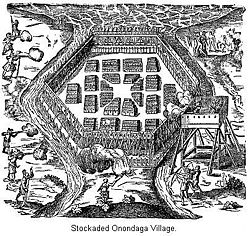Haudenosaunee men wear gustowehs. It is a fitted hat that is decorated with hawk pheasant or turkey feathers. some art decorated with silver animal hide, and hair.
 |
The Iroquois Confederacy (Haudenosaunee), complete with a constitution known as the Gayanashagowa (or "Great Law of Peace"), was established prior to major European contact. The exact date of its establishment is not known, although it has existed continuously existed since at least the fourteenth or fifteenth century.
Oral tradition tells of how the Seneca, Cayuga, Onondaga, Oneida, and Mohawk people had been warring against each other causing great bloodshed. To address this, the Creator sent a messenger to remind the people of the true lifestyle so that they could live in peace. The two spiritual leaders, Ayonwentah (generally called Hiawatha due to the Longfellow poem) and Deganawidah, "The Great Peacemaker," brought the message of peace to the five tribes. In their travels to find the leaders of the five peoples, they came upon a woman who gave them shelter. She accepted their message and the Peacemaker set aside a special duty for women, the "Clan Mother."
According to legend, an evil Onondaga chieftain named Tadadaho was the last to be converted to the ways of peace. Tadadaho was said to be so evil that his body was twisted and snakes grew from his head. Hiawatha and the Great Peacemaker "combed the snakes" from Tadadaho's hair and he accepted the message, becoming the spiritual leader of the Haudenosaunee. This event is said to have occurred at Onondaga Lake near Syracuse, New York. The title, Tadadaho, is still used for the league's spiritual leader, the fiftieth chief, who sits with the Onondaga in council.
The combined leadership of the Nations is known as the Haudenosaunee, which means "People of the Long House." The term is said to have been introduced by the Great Peacemaker at the time of the formation of the Confederacy. It implies that the Nations of the confederacy should live together as families in the same long house. Being centrally located with the Cayuga and Seneca to their west and the Oneida and Mohawk to their east, the Onondaga were charged with keeping the flame of the Council Fire burning in the council longhouse where the council of the confederacy met. Thus they were known as the "Keepers of the Fire," Kayečisnakweˀnì•yuˀ (Rudes 1999). A sixth tribe, the Tuscarora, joined after the original five nations were formed.
Once they ceased most infighting, the Confederacy rapidly became one of the strongest forces in seventeenth and eighteenth century northeastern North America. The Haudenosaunee engaged in a series of wars against the French and their Iroquoian-speaking Wyandot ("Huron") allies, another Iroquoian people but a historic foe of the Confederacy. In 1615, Samuel de Champlain was escorted through the Peterborough area by a group of Hurons. He used the ancient portage between Chemong Lake and Little Lake (now Chemong Road). The party passed Lake Ontario at its eastern tip where they hid their canoes and continued their journey by land. They followed the Oneida River until they found themselves at an Onondaga fort. Pressured by the Hurons to attack prematurely, the assault failed and they were forced to flee.
By 1677, the Iroquois formed an alliance with the English through an agreement known as the Covenant Chain. Together, they battled the French and their Huron allies.
In the American Revolutionary War, the Onondaga were at first officially neutral, although individual Onondaga warriors were involved in at least one raid on American settlements. After an American attack on their main village on April 20, 1779, the Onondaga later sided with the majority of the Haudenosaunee and fought against the United States in alliance with the British. Thereafter, many Onondaga followed Joseph Brant to Six Nations, Ontario, after the United States was accorded independence.
On November 11, 1794, the Onondaga Nation, along with the other Haudenosaunee nations, signed the Treaty of Canandaigua with the United States, in which their right to their homeland was acknowledged by the United States in article II of the treaty.




